Preserving Trees in Construction Sites
Trees provide great benefits where we live, work, and play. Our close proximity to trees may conflict in land preparation for construction. Building foundations, sidewalks, sewer lines, and roads can cause numerous changes in the environment. Post-construction landscaping, such as installing underground sprinklers, laying sod grass, and planting flowers and shrubs, can further change the environment. Many of these changes can be devastating to trees.
Trenching, soil compaction, soil clearing, and grading are common construction activities that cause stress. Stress from these activities can slowly kill healthy shade trees in what is termed a “mortality spiral” (Figure 1).
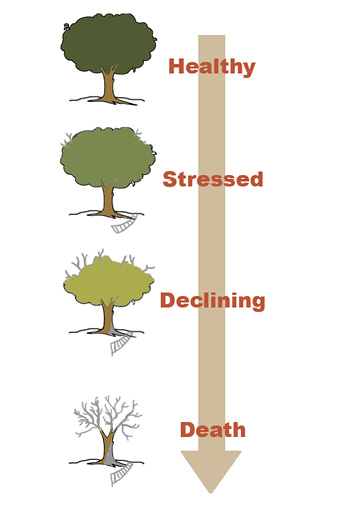
The downward spiral begins when one stress weakens a tree and sets the tree up to be injured by another stress that normally would not cause damage. As a result, drought and insect or disease defoliation can be deadly when combined with construction. As stresses accumulate, a tree becomes weaker and weaker and continues down the mortality spiral. The owner of the tree usually only becomes aware that tree damage has occurred once health is poor and decline is clearly visible. Once a declining tree displays many dead branches and twigs, most restorative treatments are ineffective. At this point, emergency care by a tree preservation specialist is expensive and carries no guarantee of success. Very few trees that show decline can escape the mortality spiral and survive. The mortality spiral’s end is typically death, and it can be caused by a fatal combination of structural failure, health degradation, and pest infestation.
Keeping construction activities and trees separated is the cheapest and easiest way to prevent damage and stress on trees. The good news is that most trees will survive construction if they can be kept separate from activity. To be successful, all phases of construction need to include protection of trees. The appendix outlines the steps needed to help protect trees during planning and mapping, preconditioning, and supervision of construction. Diligence is required because a moment of carelessness can kill a tree. If tree damage does occur, immediately apply treatments to speed recovery. In addition to protection, provide the highest quality of care to trees before, during, and after construction to reduce stress and increase survival.
Tree evaluations before construction help save money by determining which trees to preserve and which to remove. Just as it is financially foolish to kill desired trees that can be saved, it is foolish to spend money trying to save trees that should be removed. Trees marked for preservation should have a good chance to survive construction activities, adapt well to the new environment, and look good in the new landscape. Sometimes it is impossible to completely separate a tree from construction activity. For these trees, estimates of additional costs for adjusting construction along with estimates of tree damage and likelihood of survival are needed. The decision to preserve or remove a tree can depend on the comparison of costs to the likelihood of survival. Only trees that are expected to survive at a reasonable price should be saved. Trees that should be removed include those with an excessive cost estimate or damage assessment.
Trees and Roots
Trees are the biggest organisms on earth and are twice as large as they appear. We only see branches, leaves, and the stem, which are the aboveground parts of a tree. Construction activities usually cause less damage to the aboveground parts because damage is visible. At that point, it is easy to determine which contractor is accountable. Most construction related damage is inflicted belowground on the root system. Root damage usually goes unseen and without knowledge of its occurrence from both the contractors or owner.
The root system is easily damaged because it is much larger and closer to the soil surface than many would believe. To illustrate the size of the root system, a tree can be represented by a wine glass on a large dinner plate (Figure 2). The cup or basin of a wine glass represents the branches and leaves. The glass stem represents the trunk. The glass base is comparable to the root plate that contains structural roots that hold up a tree. This root plate occurs even when a taproot is formed so it can give a tree additional support. The large dinner plate the wine glass rests upon represents the transport and feeder root system.
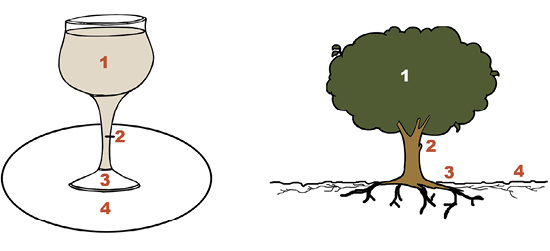
Transport and feeder roots collect water and nutrients. They are also the production center for amino acids and proteins used by trees. Transport and feeder roots stay near the surface, with approximately 85 percent of all roots being in the top 18 inches of soil. The soil surface has the highest density of roots because there is ample oxygen and microbial action. It also has the best opportunity to catch water from rainfall. Root hairs and associated mychorrizae fill soil cracks and crevices and become inseparable from the soil. Transport and feeder roots commonly grow outward, one to two times the height of a tree or up to three times further than the drip line. Thus, roots cover two to three times more land area than the aboveground parts. Consequently, roots are susceptible to construction damage because they occupy a large area and are concentrated at the soil surface. Roots are the most difficult part of a tree to protect and their damage is the most likely cause of death.
Roots and Soil
Tree health depends on healthy soil that supports small feeder roots and their associated mychorrizae. Figure 3 depicts the ideal soil for tree root expansion. The target or goal for ultimate tree health is 5 percent organic matter, 50 percent mineral particles, and 45 percent pore space. Pore space should be half filled with water and half filled with air. Most soils around homes are less than ideal; rarely do these soils have enough pore space, organic matter, and nutrients.
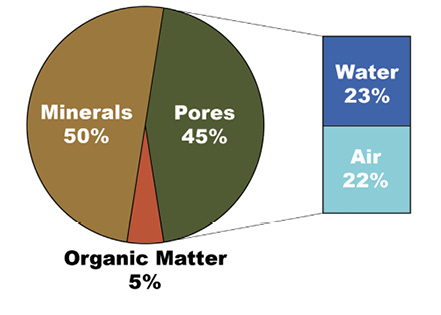
Figure 4 shows how sand, silt, and clay particles determine soil mineral texture. The ideal soil texture is a loam, composed of approximately 40 percent sand, 40 percent silt, and 20 percent clay. Natural formation of pedons or small soil blocks are also important. Pedons give soils structure and hold open small cracks and pore spaces. Pores and cracks between pedons provide air and water movement to support microorganisms and roots. Organic matter provides energy to create and support pedon development. Organic matter also attracts a large variety of creatures including earthworms, crickets, mites, and moles that move through soil, creating large pore spaces. Not protecting soil from vibrations and pressure during construction leads to crushed pedons and squeezed pore spaces. Soil compaction crushes and kills roots and associated mychorrizae because feeder roots exist in those pore spaces.

Roots are adaptable and will survive and grow where adequate water is available, temperatures are warm, and oxygen is present. However, there is a limit to what roots can tolerate. Soils can stop all root growth if they are compacted. If they are compacted, they will have less than a 12 percent pore space and a bulk density greater than 1.4 to 1.8 grams per cubic centimeter, depending on soil texture (Table 1). Bulk density increases with compaction since it is the ratio of soil dry weight to volume. Root elongation also stops once penetration resistance reaches three million pascals (435 psi). Low water and oxygen levels can also kill roots. If construction activity causes any of these soil characteristics to fall outside tolerable limits, roots will suffer and tree health will decline.
|
Soil Characteristics Important to Roots |
Tolerable Minimum |
Tolerable Maximum |
|---|---|---|
|
Air Pore Space |
12 percent |
– |
|
Bulk Density Clay |
– |
1.4g/cc |
|
Sand |
– |
1.8g/cc |
|
Penetration Resistance1 |
0.01kPa |
3,000kPa |
|
Oxygen in Soil Air for Root Survival |
2.5 percent |
21 percent |
|
Oxygen in Soil Air for Root Growth |
5 percent |
21 percent |
|
Oxygen in Soil Air for Root Initiation |
12 percent |
21 percent |
|
Oxygen in Soil Air for Efficient Element Absorption |
15 percent |
21 percent |
|
Water Content |
12 percent |
40 percent |
|
Temperature for Root Growth |
40°F |
94°F |
|
pH (wet soil) |
3.5 |
8.2 |
1Resistance level kPa = 1,000 pascals of force; 1,000 kPa = 1 MPa or 1 million pascals of force = 10 bars = 145 psi or pounds per square inch.
Penetration resistance of surface soil is good to monitor in the case of soil compaction on a construction site. Resistance measurements are closely related to bulk density. Soil penetrometers are easy to use and typically inexpensive, ranging from $60 upward. They measure pressure needed to overcome resistance and press a probe into moist mineral soil. Measuring penetration resistance in the top two inches of soil is important. This is the first place compaction occurs. Any increase in resistance causes root elongation to decrease rapidly (Figure 5). Even minor soil compaction that increases penetration resistance to 100 kPa (0.0145 psi) will reduce root elongation 90 percent. Thus, it doesn’t take much vehicular traffic or other construction activities to ruin the soil for tree roots.
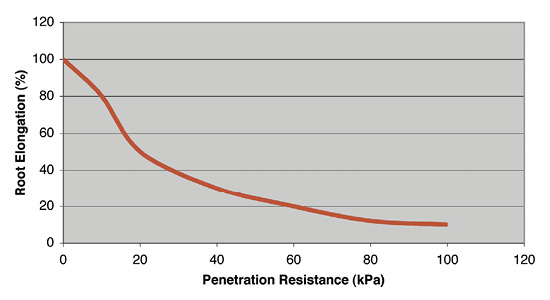
Soil in a construction area should be viewed as a single use resource – to be used for either structure support or for tree roots, but not for both. Soil compaction under structures is an essential part of construction. Vibration and pressure are purposely applied to compact soils. This increases strength and allows for them to meet weight-bearing standards. Structures like buildings and sidewalks need firm soil foundations. Roots and other organic matter are also removed to improve strength. Pore space is compressed to resist water infiltration and stabilize the soil. Therefore, loss of tree roots and rooting space under structures is to be expected. Plan ahead to locate structures far away from protected trees so each can have its own soil resource.
Which Trees Should Be Saved?
The decision of which trees to preserve and which to remove should be based on a tree evaluation. An initial walk-through can identify valuable trees that the owner or builder has an interest in saving. Tree condition, size, and species are important factors in determining which trees to save. Exact location and elevation are also needed to pinpoint tree locations on construction plans (Figure 6). In general, trees located more than 20 feet away from buildings, and not directly in driveways and sidewalks, are possible candidates for saving. Some large, sensitive trees may require more distance. Trees located less than 20 feet from a new building are always recommended for removal. There is not enough room for both normal construction activity and root protection. Therefore, either remove these trees or alter the building design.
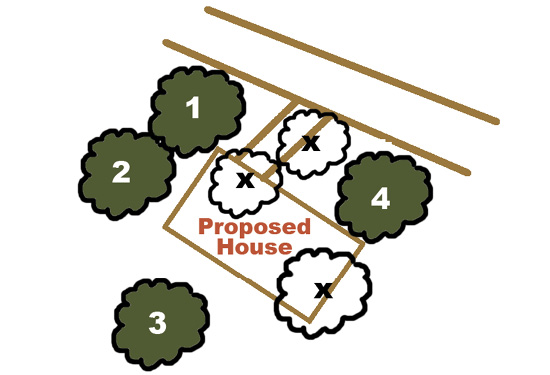
Tree condition is a judgment on how far a tree has moved down the mortality spiral. It combines an evaluation of both tree health and tree structure. Condition can be graded good, fair, or poor (Figure 7). Good condition trees are both healthy and structurally safe and are the most suitable for saving. No branch dieback should be observed, and leaf density color and size look normal. There should only be minor stem and root collar damage. Rot is not obvious, but decay fungi should not be present. Fair condition trees are judged to be halfway down the mortality spiral. They are only marginally suitable for saving. Dieback may be seen in one to two large upper limbs and foliage may look sparse, smaller, and off-color. Stem and root collar damage can cover up to 20 percent of circumference. Rot may be present and some decay fungi may be found. Poor condition trees are judged to be near death. They show dieback in three or more major upper branches, exhibit sparse small yellow leaves, and reveal that up to 40 percent of the stem/root collar circumference is damaged and rotten. A number of other characteristics can place trees in the poor condition category (Figure 8). Trees in poor condition are not suitable for saving.
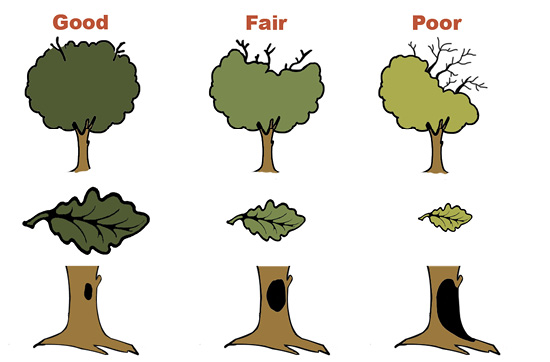
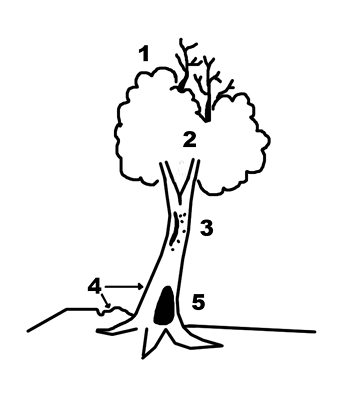
Ownership goals and finances can also help determine which trees to save or remove. In many cases, large and highly valued trees are the most difficult and costly to save. This is because as tree size increases, the size of the root system needing protection also increases. Costs can escalate when trying to adjust construction to save large trees. Owners must be willing to pay the extra expense in time and money. Small trees, on the other hand, may be low in value, but they are much easier and cheaper to protect and save.
Finally, certain species of trees, such as oaks, are more desirable for saving than others. Preferred species have structurally stronger branches, stem, and roots. They should also have a longer than average life span and display few pest problems. A preferred species should also be resistant to construction damage. Resistance means a higher survival rate under the same level of damage, whereas susceptible species will die more easily. Consequently, they need to be treated more carefully (see Species Resistance to Construction Damage section).
Species Resistance to Construction Damage
Resistant
- Ash - Green
- Bald cypress
- Birch - River
- Elm - most species
- Gum - Black, Tupelo
- Hickory - Water, Pecan
- Holly - American, Dahoon, Gallberry, Yaupon
- Maple - Red, Boxelder
- White Oaks - White, Swamp Chestnut, Overcup, Bur
- Red Oaks - Water, Willow, Shumard, Nuttall, Northern Pin
- Pines - Loblolly, Longleaf, Slash
- Willow
Moderate
- Ash - White
- Dogwood - Flowering
- Hickory - Pignut, Shagbark, Mockernut
- Hophornbeam - Eastern
- Hornbeam - American
- Magnolia - most species
- Maple - Florida
- Pine - Shortleaf
- Sweetgum
- Sycamore - American
Susceptible
- Basswood
- Beech
- Chinkapin - Allegheny
- Maple - Silver
- Sourwood
- Sugarberry (Hackberry)
- Walnut - Black
- Yellow - Poplar
Protection Guidelines for Trees
How should trees be protected from injury?
Ideally, a tree protection zone should be established using protective fencing. There should be zero tolerance for any construction activity within this zone. The combination of erecting protective fencing around trees and posting “Keep Out” signs are effective in excluding construction activity at first (Figure 9). As construction progresses, and plans change, workers often try to move and or remove these fences. Maintain and protect the tree protection zone by assigning a worker on site to this duty. A penalty clause in contracts can also remind subcontractors and workers to respect tree protection fences.

Before construction begins, improve soil conditions within the tree protection zone. The goal is to encourage new root growth in the protected zone and not in the unprotected soil. The best treatment is mulching the protection zone to a depth of 4 to 6 inches. Pine, cypress, and hardwood chips (wood and bark) are common mulches used to add organic matter to the soil. Avoid piling mulch against tree stems. Before mulching, apply a slow release fertilizer (N-P-K quantity based on soil testing). Water soil during droughts to maintain tree vigor. An application of paclobutrazol at the base of trees before construction can be effective at encouraging trees to produce new roots and repair root damage.
How large is the recommended tree protection zone?
It is recommended that a protective fence be erected 1.25 feet in radial distance away from a tree for every inch in stem diameter. Diameter is measured 4.5 feet above ground. This radial distance is termed the “critical root radius” and the resultant circle is termed “critical root area” (Table 2). Protecting this critical root area is important for tree health. Loss of roots located outside the circle is not expected to cause serious problems. More protection will be needed for trees that are old, in fair to poor health, or for damage sensitive species (see Species Resistance to Construction Damage section). For these trees, place a protective fence outside the dripline or 1.5 feet in radial distance per inch diameter, whichever is greater. When protecting a group of trees, determine the critical root radius for each individual tree. Place a protective fence outside the critical root radius of all trees in the group (Figure 10).
Stem diameter is measured 4.5 feet aboveground
Critical Root Radius or r (ft) = 1.25 x diameter (in)
Critical root area = π x r²

|
Tree Stem Diameter (in) |
Critical Root Radius (ft) |
Critical Root Area (ft2) |
|---|---|---|
|
2 |
2.5 |
19 |
|
4 |
5 |
78 |
|
6 |
7.5 |
176 |
|
8 |
10 |
314 |
|
10 |
12.5 |
490 |
|
12 |
15 |
706 |
|
14 |
17.5 |
962 |
|
16 |
20 |
1,256 |
|
18 |
22.5 |
1,590 |
|
20 |
25 |
1,963 |
|
22 |
27.5 |
2,375 |
|
24 |
30 |
2,827 |
|
26 |
32.5 |
3,318 |
|
28 |
35 |
3,818 |
|
30 |
37.5 |
4,417 |
|
32 |
40 |
5,026 |
|
34 |
42.5 |
5,674 |
|
36 |
45 |
6,361 |
|
38 |
47.5 |
7,088 |
|
40 |
50 |
7,853 |
Can a tree be saved if only part of the critical root area is protected?
Tree survival is close to 100 percent when the entire critical root area is protected. As percentage of protected area decreases, the less likely a tree is to live. To calculate this protected percentage, first measure the area within the proposed tree protection zone. Next, determine the recommended minimum critical root area using Table 2 as a guide. Compare the protected area to the minimum critical root area using the formula:
Protected Critical Root Area (%) = [Tree Protection Zone (ft²) / Critical Root Area (ft²)] x 100
Trees recommended for saving are those that can have a tree protection zone covering 70 percent or more of the critical root area. The likelihood of survival is high unless a tree is unhealthy or is a susceptible species. To improve survival, place a 1-foot thick layer of mulch over critical root areas outside protective fencing. Thick mulch will reduce soil surface compaction from traffic. A tree would be recommended for removal if the tree protection zone is only 40 percent or less of the critical root area. Survival is unlikely for trees with so much of their critical roots unprotected. It is a judgment call for trees with only 50 to 60 percent of their critical root systems protected. These trees have approximately a 50 percent chance of survival (Example 1). The owner will have to accept a high risk of loss or adjust construction activity to save these marginal trees.
Example 1. Is a 15 x 15 foot tree protection zone adequate for a 10-inch diameter tree?
Calculations:
Critical root area for a 10 in tree = 490 ft² (from Table 3)
Protected zone 15 x 15 ft square = 225 ft²
Protected Critical Root Area (%) = [490 ft²] x 100 = 46%
Answer: No! Survival rate is estimated to be below 50 percent. You need to make the protection zone larger to increase survivability. An adequate zone would measure 20 x 20 feet, protecting 80 percent of the critical roots. If the protected zone cannot be enlarged, remove the tree.
How close can trenches get to trees?
Any linear excavation for utility lines, foundations, roads, and sidewalks is considered trenching. Foremost, no trenching should ever be allowed to damage the structural root plate (Figure 2). Trenching through the root plate will leave a tree unable to hold itself up in windy conditions. The minimum distance needed between trenching and trees to protect root plates increases with tree diameter (Figure 11). Root plate size reaches a maximum 10-foot radius when stem diameter is around 2 feet. Again, always trench outside the root plate. If utilities have to be placed in the root plate area, drilling under the tree and hand excavation are better alternatives to trenching if the tree health is a consideration.

The percentage of root loss from a single trench can be estimated by first determining the shortest distance from the tree to the trench. Express this distance as a percent of the critical root radius using the following formula.
Distance from trench to tree (% of Critical root radius) =
[Distance from trench to tree (ft) / Critical root radius (ft)] x 100
Use Figure 12 to estimate root loss. No more than 40 percent root loss should be expected; otherwise, drill under the roots, move the trench, or remove the tree. Trenching on one side to 60 percent of the critical root radius will result in a 30 percent critical root area loss, and the tree is expected to survive the trenching damage (Example 2).

If two trenches are routed on the same side of a tree, calculate root loss based on the closest trench. If trenches are routed on different sides of a tree then add root losses attributable to each. During excavation, cut roots sharply and avoid pulling roots out. If soil and roots in trenches are left exposed, keep the area moist by covering with wet burlap or black plastic.
Example 2. Will a 20-inch diameter tree survive a trench that is dug 15 feet away?
Root Plate: The root plate for a 20-inch diameter tree has a 9-foot radius (Figure 11). A trench dug 15 feet away is outside the root plate.
Critical Roots:
Critical root radius = 20 in diameter tree x 1.25 = 25 ft
Distance from trench to tree (%) = 25 ft x 100 = 60%.
A distance of 15 ft is 60% of the critical root radius of 25 ft.
Using Figure 13, trenching at 60 percent of the critical root radius will cause the loss of 30 percent of the critical root area.
Answer: Yes, the 20-inch diameter tree will likely survive. No damage to the root plate is expected and more than 70 percent of the critical root area is still intact.

Will soil grade changes kill a tree?
The two types of grade changes are fill and cut. Fill raises the level of the soil and buries the original soil. Damage to root systems occurs primarily by cutting off the oxygen supply. Fills can also disrupt normal water flow and cause excessive soil moisture. The maximum depth of fill that can be tolerated by tree roots depends on texture of the fill material (Figure 14). Since sand is porous, up to 8 inches of sand can be added without much damage, whereas only 1 inch of clay could cut off the oxygen supply. Special fill mixtures have been somewhat successful up to 4 feet deep. Always keep fill from touching the stem. Avoid compaction of fill or the original surface when adding in fill material.

Cuts lower the soil level and remove topsoil along with feeder roots. The amount of damage that cuts can cause on a root system depends on texture of the original soil. The coarser the soil texture, deeper the roots tend to be, and the deeper a cut can be made before serious damage is done (Figure 15). No cuts should be allowed in the structural root plate area. Excavate the finish grade by hand and prune exposed roots. Mulch the area immediately after cut is completed. If the cut causes inadequate soil moisture by redirecting water flow or lowering the water table, add supplemental irrigation. If large grade changes are needed, a retaining wall or crib can be used (Figure 16). Retaining walls allow deep fills and cuts while still protecting the original soil level within the critical root area.


Ameliorate Compaction
One of the most common soil disturbances during construction is soil compaction. There are four treatments available to ameliorate compaction and increase aeration.
- Create holes and fractures in the soil to provide air space. This is accomplished using high-pressure injectors or augers (Figure 17).
- Dig trenches one to two feet deep oriented like spokes of a wagon wheel around a tree. Hydroexcavation works well here. Replace soil with a porous material.
- Cover the critical root area of a tree with 4 to 6 inches of organic mulch.
- Treat trees with paclobutrazol or another tree growth regulator. To receive full benefits from treatment apply immediately following damage.
Do not let compaction move a tree down the mortality spiral before treating. These four treatments can be effective individually and in combination.
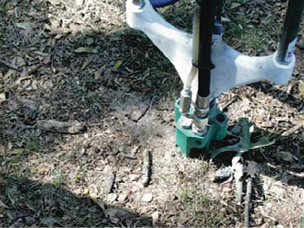
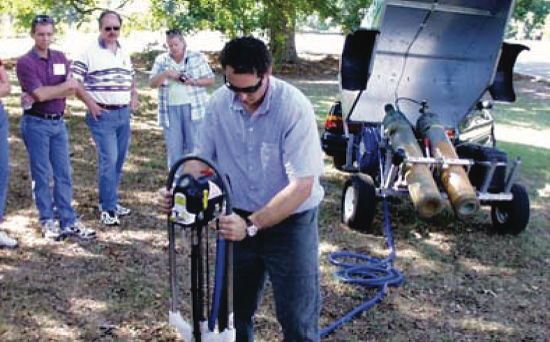
Figure 17. Reducing soil compaction using a high-pressure air injector. Cracking of soil indicates some relief from compaction.
Summary
Protection and the highest quality of care are the keys to preserving trees in construction sites. Health decline and death following construction are usually caused by damage inflicted on the root system. Soil compaction, trenching, and grading are common activities that damage roots. These activities should not be allowed in the critical root area. The critical root area is a circle surrounding a tree with a radius of 1.25 feet or more for each inch in stem diameter. Protective fencing at this distance is effective at keeping construction activities away and preventing damage. Stimulate new root growth inside fencing with ideal soil conditions; organic mulch 4 to 6 inches deep, fertilizer, and irrigation. The decision on which trees to preserve should be based on an evaluation of tree condition, size, species, and location. Trees marked for preservation should have a good chance of survival, adapt well to the new environment, and look good in the new landscape. If construction activity occurs within the critical root zone, estimate root damage and likelihood of survival. Only trees with more than a 50 percent chance of survival should be protected. Others should be removed. Several treatments are effective at ameliorating soil compaction, but they must be applied immediately for full benefit.
References
Coder, K. 1996. Construction damage assessments: trees and sites. University of Georgia Cooperative Extension Service Forest Resources Bulletin FOR96-39. Athens: University of Georgia: 23.
Elmendorf, W., H. Gerhold, and L. Kuhns. 2017. A guide to preserving trees in development projects. University Park, PA: The Pennsylvania State University: 27.
Fazio, J. R. (ed). 2000. The way trees work – how to help. Tree City USA Bulletin No. 38. Nebraska City, NE: The National Arbor Day Foundation: 8.
Matheny, N. and J. Clark. 1998. Trees and Development: A Technical Guide to Preservation of Trees During Land Development. Champaign, IL: International Society of Arboriculture: 183.
Neely D. and G. Watson. (ed). 1998. The Landscape Below Ground II. Champaign: IL: International Society of Arboriculture: 265.
Appendix
Steps to Protect Trees from Construction Damage
Step 1. Mapping and Prescription
- Determine what the client desires and the relative importance of preserving trees.
- Inventory the construction site and prepare a map that identifies soil, trees, vegetation, and other resources. Determine which trees are healthy, structurally sound, and located away from proposed construction.
- Include in the construction plan:
- A map showing where protection fences are to be located and areas off limits to construction activity.
- A list of construction alterations needed to protect important trees.
Step 2. Preconditioning
- Build access roads and staging areas for construction workers. Ideally these should be part of the final site design. Confirm that trees are safe from soil sterilants to be used.
- Review location of proposed lines, trenching, and tunneling activities with utility personnel.
- Cut and remove (do not pull) unwanted trees and vegetation in protected areas. Fertilize and mulch the protected root zone of trees to be saved.
- Install protective fences, drainage, and irrigation (if needed).
- Determine where to hold topsoil and where construction spoil will be piled.
Step 3. Supervision
- Meet with general contractor:
- Agree on construction limits, sites for material storage, parking areas for workers, and location of trailer and portable toilets.
- Agree on material disposal, especially cement, paint, and plastic.
- Agree on management of water. This includes erosion, storm-water runoff, and cleaning cement trucks.
- On the first day, make sure someone is charged with protecting fences from encroachment.
- Install utility lines first, driveways, walks, and parking second, and buildings last.
- Check all last minute changes against the plan to ensure tree protection.
- Inspect the site twice a day.
- Provide extra water, fertilizer, and insect and disease control to protected trees.
- Prune/repair injured trees. Reestablish favorable soil conditions following any disturbance.
- Maintain mulch.
Step 4. After-Care
- Remove temporary fences and irrigation systems.
- Rehabilitate compacted and eroded areas.
- Provide extra water, fertilizer, and insect and disease control to protected trees.
- Maintain mulch.
Copyright International Society of Arboriculture. Used with permission.
Funded by an Urban & Community Forestry Grant from the Mississippi Forestry Commission in cooperation with the USDA Forestry Service and the Southern Group of State Foresters.
The information given here is for educational purposes only. References to commercial products, trade names, or suppliers are made with the understanding that no endorsement is implied and that no discrimination against other products or suppliers is intended.
Publication 2339 (POD-08-22)
Distributed by Brady Self, PhD, Associate Extension Professor, Forestry; from an earlier version by Stephen Dicke, PhD, Emeritus Extension Professor, Forestry.
The Mississippi State University Extension Service is working to ensure all web content is accessible to all users. If you need assistance accessing any of our content, please email the webteam or call 662-325-2262.


